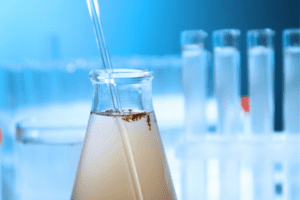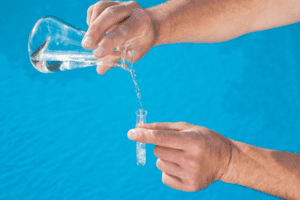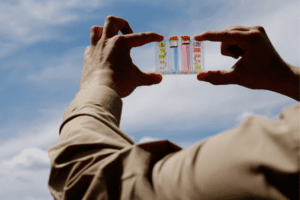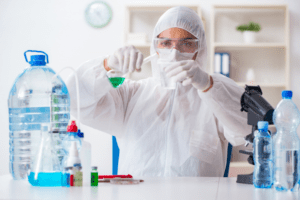
So, What Exactly Do I Test My Water For?
The water quality test you perform will reveal the presence of certain contaminants in your water. These can come from a variety of sources, including run-off from agriculture or manufacturing, natural sources like minerals leaching into water supplies, or even from your own home if you have old pipes or fixtures. The most common water quality tests measure for the presence of:
- Bacteria and microorganisms
- Chlorine
- Lead
- Nitrates and nitrites
- pH levels
Why Is Water Quality Testing Important?
Water quality is important for both human consumption and environmental protection. Water quality testing can help you find out if your water is safe to drink and use, and if not, what needs to be done to improve it. Poor water quality can lead to a number of health problems in people, including gastrointestinal illness, reproductive problems, and even neurological disorders. It can also be harmful to the environment, causing problems for plants, animals, and aquatic life.

What Are the Steps for Water Quality Testing?
There are a few different ways to test your water quality. You can either do it yourself with a water quality test kit, or you can have it done by a professional.
If you're doing it yourself, the first step is to collect a water sample. The most common way is to use a water quality test kit that you can buy at most hardware or home improvement stores. You'll need to use a clean container to collect the water, and you should be careful not to touch the inside of the container with your hands. Once you have your water sample, you'll need to follow the instructions that come with your water quality test kit. Generally, you'll add a water sample to a vial of water quality test solution and then compare the color of the water in the vial to a chart that comes with the kit.
If you're having your water quality tested by a professional, they will usually come to your home and collect a water sample for you. They will then send the water sample off to a laboratory for testing.

What Water Quality Test Should I Use?
Once your water sample has been collected, it will be tested for a variety of different things. The most important thing that your water quality test will measure is the level of contaminants in your water. The type of test you use depends on what contaminants you want to measure for. The most common ones are:
- pH test: This measures the acidity or alkalinity of your water.
- Chlorine test: This measures the amount of chlorine in your water.
- Hardness test: This measures the amount of minerals in your water.
- Lead test: This measures the amount of lead in your water.

Understand What You Are Testing For
- Acidity or Alkalinity: The pH of water is a measure of its acidity or alkalinity. Water with a high pH (above 8.5) is considered basic, while water with a low pH (below 6.5) is considered acidic. Most water quality tests will not measure the pH of your water. However, if you are concerned about the acidity or alkalinity of your water, you can purchase a pH testing kit at most hardware stores.
- Hardness: Hard water is water that contains dissolved minerals, such as calcium and magnesium. Hard water is not a health concern, but it can be a nuisance because it can leave mineral deposits on fixtures and cause soap to form scum. You can test the hardness of your water with a water hardness testing kit, which is available at most hardware stores.
- Total Dissolved Solids (TDS): TDS is a measure of the dissolved minerals, salts, and other small particles in water. High levels of TDS can make water taste salty or bitter and can also be a sign of water pollution. You can test for TDS with a TDS meter, which is available at most hardware stores.
- Coliform bacteria: Coliform bacteria are a group of bacteria that includes pathogens (disease-causing organisms). While most coliform bacteria are not harmful, their presence in water can indicate that harmful pathogens may be present. You can test for coliform bacteria with a water quality testing kit, which is available at most hardware stores.
- Radon: Radon is a gas that can be found in water. It is invisible and odorless, but it can be harmful to your health if you are exposed to high levels of it. You can test for radon with a water quality testing kit.
- Metals: Metals, such as lead and copper, can be found in water. They can be harmful to your health if you are exposed to them. You can test for metals with a water quality testing kit.
- Corrosion: Corrosion is the process of water breaking down metal pipes. It can cause your water to have a bad taste or smell. You can test for corrosion with a water quality testing kit.
- Detergents: Detergents can be found in water. They can be harmful to your health if you are exposed to them. You can test for detergents with a water quality testing kit.
- Volatile organic compounds: Volatile organic compounds (VOCs) can be found in water. They can be harmful to your health if you are exposed to them. You can test for VOCs with a water quality testing kit.
- Pesticides: Pesticides can be found in water. They can be harmful to your health if you are exposed to them. You can test for pesticides with a water quality testing kit.

What Are the Top Water Quality Indicators?
The six main indicators of water quality are dissolved oxygen, turbidity, bioindicators, nitrates, pH scale, and water temperature. The amount of dissolved oxygen in water is an important indicator of water quality. Dissolved oxygen is necessary for fish and other aquatic life. Too much or too little dissolved oxygen can be harmful to aquatic life.
Turbidity is the measure of how cloudy water is. Turbidity can be caused by sediment, algae, or other particles in the water. Too much turbidity can make water unsafe to drink and can harm aquatic life. Bioindicators are organisms that can be used to measure the health of an ecosystem. Water quality can be measured by the presence or absence of certain bioindicators. For example, the presence of certain types of algae can indicate water pollution.
pH is a measure of how acidic or basic water is. Water with a pH of 7 is neutral, water with a pH less than 7 is acidic, and water with a pH greater than 7 is basic. water that is too acidic or too basic can be harmful to aquatic life. Dissolved oxygen is the amount of oxygen that is dissolved in water. Oxygen is necessary for aquatic life to survive.
Nitrate is a water-soluble form of nitrogen. High levels of nitrate in water can be harmful to humans and aquatic life. Not only does water temperature indicate the quality of water, but different aquatic creatures rely on specific temperatures and conditions for their optimum health. Water temperature also alters other aspects of water quality, like dissolved oxygen levels and a creature's vulnerability to parasites, pollution, and illnesses.

When Should I Test My Water Quality?
You should test your water quality at least once a year. If you have an older home or a private well, you should test it more often. Consider testing your water quality when
- Anyone in your household is pregnant
- You have a new baby in the house
- You notice strange things with the water (odd odors, tastes, stains, etc.)
- There is an unexplained illness in the house
- There has been a chemical or fuel leak near your water supply
- You have lead pipes
- There is Radon present in the air or in the region
- Your soap doesn't lather and leaves behind soap scum
- Your laundry and plumbing fixtures are stained
- The water is frothy, cloudy, or otherwise discolored or opaque
- You want softer water
- Your pipes are corroding
- Your pipes are damaged
- You live near heavy agricultural activity
- You live near mining operations
- You live near gas drilling
- You live near a gas station or underground fuel tanks
- You live near a junkyard, landfill, factory, or dry cleaners
- You live near seawater or a salted road

What Could Happen if I Don’t Test My Water Quality?
If you don't test your water quality, you could be putting yourself and your family at risk for a number of waterborne illnesses. Additionally, you could be damaging your pipes and appliances by using water with high levels of dissolved minerals or other contaminants. Finally, you may be wasting money on water treatment products that aren't necessary if you knew your water's quality was good. So, don't risk it -contact Oak Plumbing for a water quality test today!






